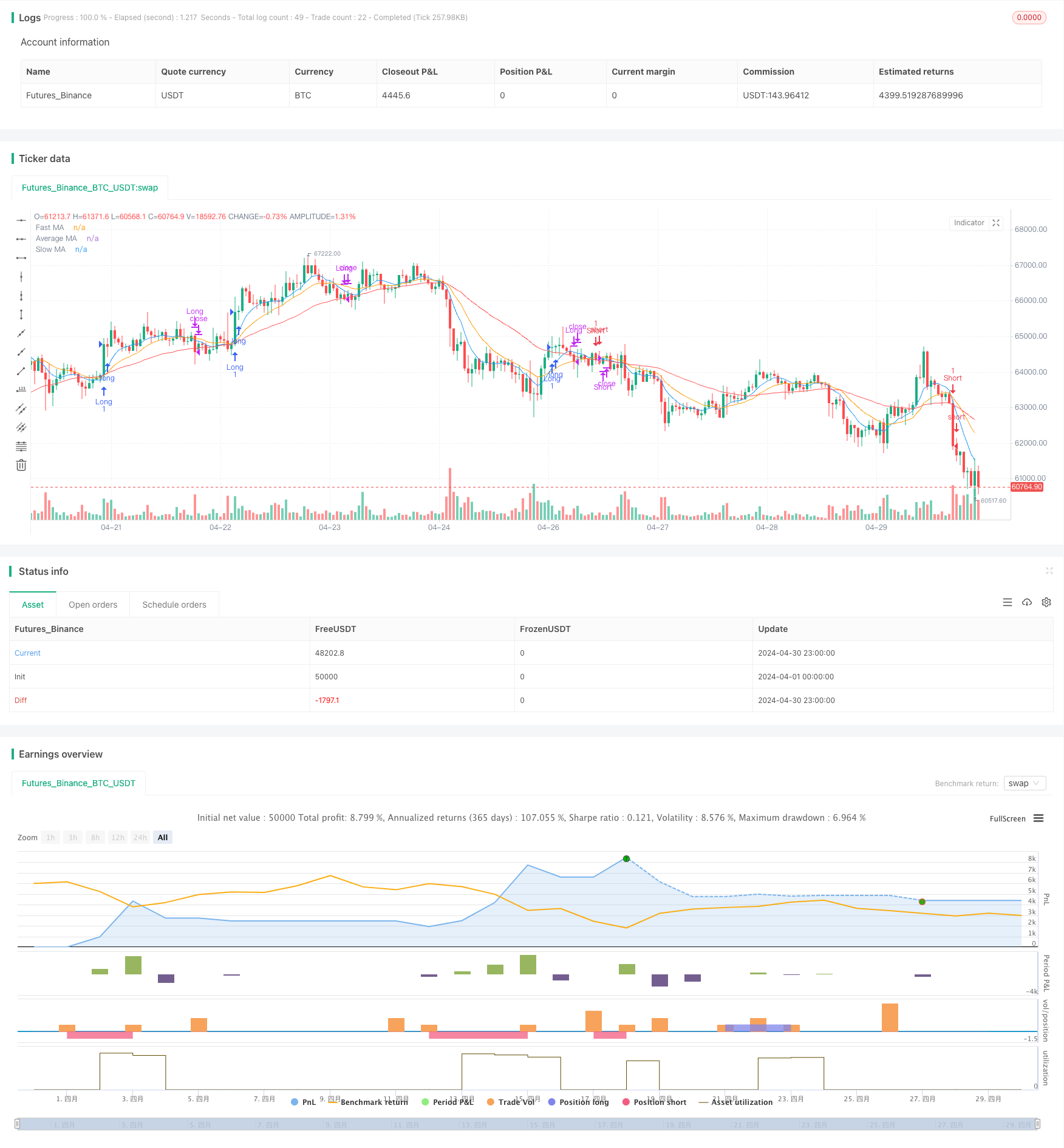ADX 필터와 함께 MA 거부 전략
저자:차오장, 날짜: 2024-05-17 10:35:58태그:ADXMAWMA

전반적인 설명
이 전략은 여러 이동 평균 (MA) 을 주요 거래 신호로 사용하고 평균 방향 지표 (ADX) 를 필터로 통합합니다. 전략의 주된 아이디어는 빠른 MA, 느린 MA 및 평균 MA 사이의 관계를 비교하여 잠재적 인 긴 및 짧은 기회를 식별하는 것입니다. 동시에 ADX 지표는 충분한 트렌드 강도를 가진 시장 환경을 필터링하여 거래 신호의 신뢰성을 향상시킵니다.
전략 원칙
- 빠른 MA, 느린 MA, 평균 MA를 계산합니다.
- 닫기 가격과 느린 MA를 비교하여 잠재적 인 긴 및 짧은 수준을 식별합니다.
- 종료 가격과 빠른 MA를 비교하여 긴 레벨과 짧은 레벨을 확인합니다.
- 트렌드 강도를 측정하기 위해 ADX 지표를 수동으로 계산합니다.
- 빠른 MA가 평균 MA를 넘고 ADX가 설정된 임계값을 넘고 긴 레벨이 확인되면 긴 입시 신호를 생성합니다.
- 빠른 MA가 평균 MA보다 낮을 때, ADX가 설정된 임계값을 초과하고 짧은 수준이 확인되면 짧은 입시 신호를 생성합니다.
- 닫기 가격이 느린 MA를 넘을 때 긴 출구 신호를 생성하고 닫기 가격이 느린 MA를 넘을 때 짧은 출구 신호를 생성합니다.
전략적 장점
- 여러 MA를 사용하면 시장 추세와 동력 변화를 보다 포괄적으로 파악할 수 있습니다.
- 빠른 MA, 느린 MA, 평균 MA 사이의 관계를 비교함으로써 잠재적 인 거래 기회를 식별 할 수 있습니다.
- ADX 지표를 필터로 사용하는 것은 불안정한 시장에서 과도한 잘못된 신호를 생성하는 것을 방지하고 거래 신호의 신뢰성을 향상시킵니다.
- 전략 논리는 명확하고 이해하기 쉽고 구현하기 쉽습니다.
전략 위험
- 트렌드가 불분명하거나 시장이 불안정한 상황에서는 전략이 많은 잘못된 신호를 생성하여 빈번한 거래와 손실로 이어질 수 있습니다.
- 이 전략은 MA와 ADX와 같은 후진 지표에 의존하고 있으며 초기 트렌드 형성 기회를 놓칠 수 있습니다.
- 전략의 성능은 매개 변수 설정 (예를 들어, MA 길이와 ADX 임계) 에 의해 크게 영향을 받으며, 다른 시장과 도구에 기반한 최적화를 요구합니다.
전략 최적화 방향
- 거래 신호의 신뢰성 및 다양성을 높이기 위해 RSI 및 MACD와 같은 다른 기술 지표를 통합하는 것을 고려하십시오.
- 시장 변화에 적응하기 위해 다양한 시장 환경에 대한 다른 매개 변수 조합을 설정합니다.
- 잠재적인 손실을 통제하기 위해 스톱 로스 및 포지션 사이즈 등 위험 관리 조치를 도입합니다.
- 보다 포괄적인 시장 관점을 얻기 위해 경제 데이터와 정책 변화와 같은 근본 분석을 결합합니다.
요약
ADX 필터와 함께하는 MA 거부 전략은 잠재적 인 거래 기회를 식별하고 저품질의 거래 신호를 필터링하기 위해 여러 MAs와 ADX 지표를 사용합니다. 전략 논리는 명확하고 이해하기 쉽고 구현 할 수 있습니다. 그러나 실제로 전략을 적용 할 때 시장 환경 변화를 고려하고 최적화를 위해 다른 기술적 지표와 위험 관리 조치를 결합하는 것이 중요합니다.
/*backtest
start: 2024-04-01 00:00:00
end: 2024-04-30 23:59:59
period: 1h
basePeriod: 15m
exchanges: [{"eid":"Futures_Binance","currency":"BTC_USDT"}]
*/
// This Pine Script™ code is subject to the terms of the Mozilla Public License 2.0 at https://mozilla.org/MPL/2.0/
// © gavinc745
//@version=5
strategy("MA Rejection Strategy with ADX Filter", overlay=true)
// Input parameters
fastMALength = input.int(10, title="Fast MA Length", minval=1)
slowMALength = input.int(50, title="Slow MA Length", minval=1)
averageMALength = input.int(20, title="Average MA Length", minval=1)
adxLength = input.int(14, title="ADX Length", minval=1)
adxThreshold = input.int(20, title="ADX Threshold", minval=1)
// Calculate moving averages
fastMA = ta.wma(close, fastMALength)
slowMA = ta.wma(close, slowMALength)
averageMA = ta.wma(close, averageMALength)
// Calculate ADX manually
dmPlus = high - high[1]
dmMinus = low[1] - low
trueRange = ta.tr
dmPlusSmoothed = ta.wma(dmPlus > 0 and dmPlus > dmMinus ? dmPlus : 0, adxLength)
dmMinusSmoothed = ta.wma(dmMinus > 0 and dmMinus > dmPlus ? dmMinus : 0, adxLength)
trSmoothed = ta.wma(trueRange, adxLength)
diPlus = dmPlusSmoothed / trSmoothed * 100
diMinus = dmMinusSmoothed / trSmoothed * 100
adx = ta.wma(math.abs(diPlus - diMinus) / (diPlus + diMinus) * 100, adxLength)
// Identify potential levels
potentialLongLevel = low < slowMA and close > slowMA
potentialShortLevel = high > slowMA and close < slowMA
// Confirm levels
confirmedLongLevel = potentialLongLevel and close > fastMA
confirmedShortLevel = potentialShortLevel and close < fastMA
// Entry signals
longEntry = confirmedLongLevel and ta.crossover(fastMA, averageMA) and adx > adxThreshold
shortEntry = confirmedShortLevel and ta.crossunder(fastMA, averageMA) and adx > adxThreshold
// Exit signals
longExit = ta.crossunder(close, slowMA)
shortExit = ta.crossover(close, slowMA)
// Plot signals
plotshape(longEntry, title="Long Entry", location=location.belowbar, style=shape.triangleup, size=size.small, color=color.green)
plotshape(shortEntry, title="Short Entry", location=location.abovebar, style=shape.triangledown, size=size.small, color=color.red)
// Plot moving averages and ADX
plot(fastMA, title="Fast MA", color=color.blue)
plot(slowMA, title="Slow MA", color=color.red)
plot(averageMA, title="Average MA", color=color.orange)
// plot(adx, title="ADX", color=color.purple)
// hline(adxThreshold, title="ADX Threshold", color=color.gray, linestyle=hline.style_dashed)
// Execute trades
if longEntry
strategy.entry("Long", strategy.long)
else if longExit
strategy.close("Long")
if shortEntry
strategy.entry("Short", strategy.short)
else if shortExit
strategy.close("Short")
관련
- 동력과 부피 확증과 함께 멀티 이동 평균 거래 시스템 양적 트렌드 전략
- MA, SMA, MA 슬로프, 트래일링 스톱 손실, 재입구
- 모멘텀 이윤 취득 전략으로 멀티 MA 트렌드 강도를 포착
- 듀얼 헐 이동 평균 크로스오버 양적 전략
- 피보트 포인트 및 기울기 기반의 실시간 트렌드 라인 거래
- 다중 시간 프레임 헬스 이동 평균 크로스오버 전략
- ADX 트렌드 브레이크업 모멘텀 거래 전략
- 멀티테크니컬 인디케이터 크로스오버 모멘텀 양적 거래 전략 - EMA, RSI 및 ADX에 기초한 통합 분석
- 적응형 다중 이동 평균 크로스오버 동적 거래 전략
- 이동 평균 필터 (HBTS) 를 가진 역사적인 파격 트렌드 시스템
더 많은
- 상승 및 하락 포용 패턴과 함께 향상된 스윙 고/하락 브레이크업 전략
- ADX 필터 트레이딩 신호 전략과 Laguerre RSI
- 가격 및 부피 파업 구매 전략
- K 연속 촛불 황소 곰 전략
- 슈퍼 이동 평균 및 상단 크로스 오버 전략
- RSI, ADX 및 Ichimoku 클라우드 기반의 양적 거래 전략을 따르는 다중 요인 트렌드
- RSI와 MACD 결합된 장기 단기 전략
- 이치모쿠 클라우드와 이동 평균 전략
- 윌리엄 알리거터 이동 평균 트렌드 캐처 전략
- 동적 MACD 및 Ichimoku 클라우드 거래 전략
- 볼링거 밴드 전략: 최대 수익을 위한 정밀 거래
- ATR 평균 탈출 전략
- KNN 기계 학습 전략: K-최근 이웃 알고리즘에 기반한 트렌드 예측 거래 시스템
- CCI+RSI+KC 트렌드 필터 양방향 거래 전략
- BMSB 탈퇴 전략
- SR 탈락 전략
- 볼링거 밴드 동적 브레이크업 전략
- 8시간 에마
- RSI 양적 거래 전략
- 볼링거 밴드 ATR 트렌드 전략